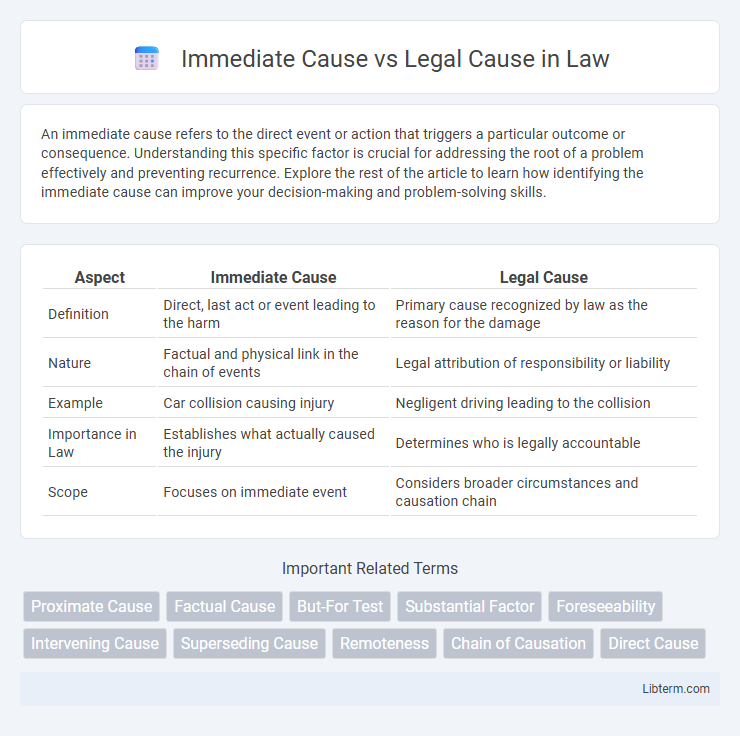An immediate cause refers to the direct event or action that triggers a particular outcome or consequence. Understanding this specific factor is crucial for addressing the root of a problem effectively and preventing recurrence. Explore the rest of the article to learn how identifying the immediate cause can improve your decision-making and problem-solving skills.
Table of Comparison
| Aspect | Immediate Cause | Legal Cause |
|---|---|---|
| Definition | Direct, last act or event leading to the harm | Primary cause recognized by law as the reason for the damage |
| Nature | Factual and physical link in the chain of events | Legal attribution of responsibility or liability |
| Example | Car collision causing injury | Negligent driving leading to the collision |
| Importance in Law | Establishes what actually caused the injury | Determines who is legally accountable |
| Scope | Focuses on immediate event | Considers broader circumstances and causation chain |
Introduction to Immediate and Legal Cause
Immediate cause refers to the direct, physical event that leads to a result or injury, pinpointing the exact action or condition triggering an outcome. Legal cause, also known as proximate cause, establishes a sufficient connection between an act and the injury, considering foreseeability and policy factors to determine liability. Understanding both immediate and legal cause is essential for accurately assigning responsibility in legal and medical contexts.
Defining Immediate Cause
The immediate cause refers to the direct, proximate factor that triggers an event or outcome without any intervening causes. In legal and insurance contexts, identifying the immediate cause is crucial for determining liability or coverage, as it establishes the primary reason for damage or loss. Distinguishing the immediate cause from the legal cause helps clarify responsibility by isolating the factual cause from the broader legal interpretation of causation.
Understanding Legal Cause
Legal cause, also known as proximate cause, refers to an event recognized by law as sufficiently related to an injury to hold liability. It focuses on whether the harm was a foreseeable result of the defendant's actions, rather than the closest or immediate cause. Understanding legal cause is crucial in tort law to establish responsibility and limit liability to consequences that bear a reasonable connection to the conduct.
Key Differences Between Immediate and Legal Cause
Immediate cause refers to the direct, proximate event that triggers an injury or damage, while legal cause involves the broader determination of whether the harm was a foreseeable result of the defendant's actions. The key difference lies in immediacy: immediate cause looks at the closest link to the harm, whereas legal cause addresses liability by establishing a chain of causation and foreseeability. Legal cause incorporates policy considerations and limits on liability, distinguishing it from the purely factual notion of immediate cause.
Importance in Legal Proceedings
Immediate cause identifies the closest event directly resulting in harm, making it crucial for establishing factual liability in legal proceedings. Legal cause extends beyond the immediate cause, determining whether the harm was a foreseeable consequence to assign legal responsibility. Understanding the distinction ensures accurate attribution of liability, influencing compensation outcomes and judicial fairness.
Examples Illustrating Immediate Cause
Immediate cause refers to the direct event or action that leads to a particular outcome, often seen in incidents where the last act sets off the result. For example, in a traffic accident, a driver's sudden brake failure acts as the immediate cause of the collision, overshadowing prior poor road maintenance. Another illustration is a medical case where a patient's death results directly from a surgical error, making the surgical mistake the immediate cause rather than the underlying illness.
Case Studies Demonstrating Legal Cause
Case studies such as *Palsgraf v. Long Island Railroad Co.* (1928) illustrate the distinction between immediate cause and legal cause by emphasizing foreseeability as a key factor in establishing legal cause. In *Palsgraf*, the court ruled that the defendant was not liable because the harm to the plaintiff was not a foreseeable result of the defendant's actions, highlighting that legal cause requires proximate cause beyond mere immediate cause. Other cases like *Polemis and Furness, Withy & Co Ltd* focus on the foreseeability test to delineate legal cause, reinforcing that an immediate cause must be directly linked to the harm under established legal principles for liability to be assigned.
Challenges in Distinguishing Causes
Distinguishing immediate cause from legal cause presents challenges due to the overlap in factual and legal interpretations of cause-effect relationships in law. Immediate cause refers to the direct event that precipitates harm, while legal cause involves proximate cause factors that establish liability by assessing foreseeability and policy considerations. Courts often struggle to delineate these causes clearly because multiple contributing events complicate causal chains and require nuanced analysis of intervening acts and relevance to legal responsibility.
Impact on Liability and Responsibility
Immediate cause directly establishes the proximate reason for an event, significantly influencing the determination of liability by pinpointing the actual trigger of damage or injury. Legal cause broadens this scope by incorporating foreseeability and policy considerations, thereby affecting responsibility through the application of legal standards and limits on liability. Understanding both causes is critical in assigning accountability and determining the extent of damages in civil and criminal cases.
Conclusion: Why the Distinction Matters
Distinguishing between immediate cause and legal cause is crucial in determining liability, as the immediate cause addresses the direct action or event that triggered the harm, while the legal cause encompasses broader considerations of foreseeability and responsibility. Understanding this distinction ensures that accountability is assigned fairly, preventing unjust liability for remote or unintended consequences. Accurate identification of legal cause informs judicial decisions and legal strategies, ultimately shaping the outcome of negligence and tort cases.
Immediate Cause Infographic

 libterm.com
libterm.com